Savoia-Marchetti SM 79 «Sparviero»
-

A Savoia-Marchetti SM79 “Sparviero” of the 109th air group (109 Gruppo) and the 258th air division (258 Squadriglia) of the Italian Royal Air Force (Regia Aeronautica Italiana) (©La Regia Aeronautica – Storia Militare) -
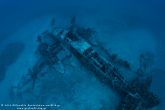
Savoia-Marchetti SM 79 «Sparviero» of Poros (© 2014 Milonakis Kostas - www.wetklik.gr - www.grafasdiving.gr) -
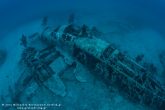
SM79 of Poros, in which the left engine, the left landing wheel, the machine gun of 12,7mm as well as the three propellers of the aircraft are discreet (© 2014 Milonakis Kostas - www.wetklik.gr - www.grafasdiving.gr) -

5 SM79 “ Sparviero“ of the 193rd air division (193 Squadriglia) in formation. Next to the pod, there is the war shield because of which the 193th division took the characteristic name “Electrical Man” (L'Omino Elettrico) (©La Regia Aeronautica – Stori -
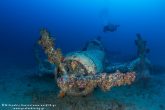
The engine of SM79 of Poros. The propellers of all engines are straight, a fact that shows that this aircraft landed compulsory, probably due to the lack of fuel (© 2014 Milonakis Kostas - www.wetklik.gr - www.grafasdiving.gr) -
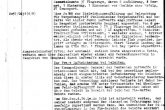
The entry of August 5th 1944 of the war diary of the German Admiralty of the Aegean Sea that informs about the attack of the 8 Italian Savoia-Marchetti SM 79 against the allied convoy at the north-west of Benghazi (Kriegstagebuch des Admiral Ägäis, Ar -
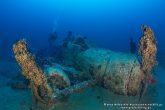
The right engine of SM79 of Poros. Even though the front part of the aircraft is under a very good condition, from the middle of pod until the wings the outside covering has left and the only visible part is its framework (© 2014 Milonakis Kostas . -

2 SM 79 of the 193rd air division (193 Squadriglia) (©La Regia Aeronautica – Storia Militare) -

A SM 79 of the 192nd air division (192 Squadriglia). On the upper part of the aircraft, one of the three machine guns of 12,7mm, that the SM 79 usually had, is discreet (©La Regia Aeronautica – Storia Militare) -

The SM 79 of Poros is sunk in a maximum depth of 59m having a north west direction of almost 30° degrees (© 2014 Milonakis Kostas - www.wetklik.gr - www.grafasdiving.gr) -

Published in the journal Free Press. -

Video from the wreck Savoia-Marchetti SM 79 «Sparviero»
Italian aircraft Savoia-Marchetti SM79 «Sparviero»
In March 2014, the diving group of Antonis Grafas dived and re-detected the Italian aircraft Savoia-Marchetti SM79 «Sparviero» that was originally detected few years ago by the professional diver Noulis Spurlakos in a depth of 59m at the south-east side of the island of Poros. Even though the aircraft had been thoroughly searched and identified as Savoia-Marchetti in 2011, almost after its discovery by a group of divers, in which the diver-researcher Giorgos Karelas was part of, its exact location was not known. The group of Antonis Grafas realized more divings in a wider area until they detected, photographed and filmed it in order to further document it.
The aircraft Savoia-Marchetti SM 79 «Sparviero» (in Greek «Geraki») was an Italian bombing aircraft with three engines of a medium size that was used by the Italian Royal Air Force (Regia Aeronautica Italiana) during the World War II. The general technical characteristics of the aircraft were the below:
Type: Bombing Aircraft
Constructor: SIAI-Marchetti
Length: 16.20m
Displacement (length from the left to the right wing): 21.20m
Height: 4.10 m
Wing surface: 61m2
Weight (empty): 7.610 kilos
Maximum weight when take off: 12.500 kilos
Engines: Three rays Alfa Romeo 126RC with 9 cylinders
Power: 1.000 PS each
Maximum speed: 434km/hour
Autonomy: 1.990km
Maximum height: 7.000m
Crew: 5 members
Indicative armament: 3 machine guns of 12,7mm, 2 machine guns of 7,7mm, capacity of transferring 2 torpedoes with 200kilos heads each
History
According to the records of August 5th 1944 of the war diary of the German Admiralty of Aegean, we are aware of the below:
“A German bombing aircraft, type Ju 88, being an identifying [1], escorted the Italian torpedo air division in order to attack to the already attacked enemy convoy by Luftwaffe at the north-west side of Benghazi. From the 8 taken-off Italian aircrafts type S79 [Savoia-Marchetti SM 79], three of them managed to detect the convoy, at the north of Benghazi, and hit it with three torpedoes. A cargo-ship of 7000 gross weight, another ship as well as a third one sank [2]. Three strong explosions were evident. There was a loose resistance from the enemy with few anti-air firing. The attack took place during midnight. The aircrafts took off from the airport of Elefsina and landed on Maleme [Crete] at 01.50am on 5.8.1944. One of the aircrafts during its return fell near the cape of Spatha [Crete].”
Today, almost 70 years later, the Italian researcher and writer Ferdinando D´Amico broaden the information that comes from the German war records, stating that the eight Italian aircrafts that participated in the attack against the mentioned allied convoy belonged to the Italian air division Gruppo Aerosiluranti «Buscaglia-Faggioni» of the Aeronautica Nazionale Repubblicana. This division continued to the war, after the Italian convention of September 8th 1943, on the side of the German army. The allied convoy – that according to the statements of Ferdinando D´Amico was located at the north-west of Tolmeitha, Libya during the Italian attack – consisted of 30 merchant ships, protected by 4 accompanied war ships and it had been already attacked by the German Luftwaffe [3]. The Italian aircrafts of Gruppo “Buscaglia” managed to hit with torpedoes the British cargo ship Samsylarna (7210 gross weight) at the indicative point 33° 5´ Β και 20° 16´ Α [4].
As Ferdinando D’Amico mentions, based on the war diary of Gruppo “Buscaglia”, only 6 of the taken off aircrafts managed to return safe to their base. However, one of them was destroyed during its landing due to a mechanical problem to its release mechanism of the left wheel. Among the aircrafts that did not return back, is also an aircraft that fell near the cape of Spatha, Crete, as it is also confirmed by the German war diary, and another one that landed compulsory near Argos due to lack of fuel. The latter, under the construction number MM. 22293 and the indicative code B2-09 is considered to be the aircraft that was detected few years ago at the south-east side of Poros by the professional diver Noulis Spourlakos.
According to the war diary of Gruppo “Buscaglia”, Savoia-Marchetti SM79 that participated in the already mentioned operation against the allied convoy was under the commander flight Lieutenant Marcello Perina. The rest of the crew was: the co-lieutenant Gianfranco Neri, mechanic the pilot officer Marcello Manfrino, wireless operator the sergeant Gieseppe Apolloni and machine gunner the assistant sergeant Franco Zanchi. All crew were members of the Gruppo Aerosiluranti “Buscaglia” that had decided to continue the war with the A.N.R [5]. According to the information of Ferdinando D’Amico no crew member got lost during the compulsory landing [6].
The wreck
The probable Savoia-Marchetti SM79 with construction number MM.22293 of Poros that was delivered to the Gruppo Aerosiluranti “Buscaglia” in June 2nd 1944, is an important historic finding of the presence and action of the fascist part of the Italian air force in Greece, after the Italian convention under the general Pietro Badoglio, in September 8th 1943. The wreck of the aircraft is located on the sandy sea bottom in a maximum depth of 59m and minimum 57m at a distance of almost 200m from the coast at the south-east side of Poros.
The pod axis of the aircraft has a north-west direction of almost 30° degrees. The group of Antonis Grafas detected two of the aircraft’s machine guns, from which the one is kept intact at the roof of the pod while the other one is located at the right side of the pilot’s cabin. The airplane’s engines are under a perfect condition and the fact that the propellers of the engines have not bended means that this aircraft landed compulsory due to lack of fuels. In the case that the aircraft would realize a compulsory landing due to a mechanical issue of one of the engines, then one of the other engines would operate and as a result the one propeller would bend due to its contact with the water surface.
The aircraft’s pod has changed over the years and due to the intense benthos coverings. From the middle part of the pod up to the wing, the external covering has gone, revealing its shell. Both wings of the aircraft are obvious at their position without their external covering. Except from the shell, the fuel deposits, the floters and the wheels, that are still on a flight position, are obvious. The tools on the cabin’s dial are still on their position even though their intense benthos covering makes them less visual. Savoia-Marchetti SM79 of Poros is a very important point of reference for those who have to do with the historic wrecks of Greece. The reason why is so important is because it is the first Italian aircraft of the World War II that was detected in the Greek land. It is not just an aircraft of Regia Aeronautica Italiana but an aircraft of Aeronautica Nazionale Republicana, i.e of that part that did not sign the Italian convention and preferred to continue the war side by side to the unstable German army force until its final fall. I hope and wish that this finding stays as it is for many years until its final absorption by its natural surroundings.
DG
Referrals, Complementary, Clarifications
[1] They had a spotlight with which they lighted the ships of the enemy convoy in order for the aircrafts carrying the air-torpedoes to see the targets.
[2] According to the allied sources, no ship sank by this Italian air-attack. Only the new British steam ship Samsylarna, type Liberty, was hit by air torpedoes. It was constructed in 1944 in Baltimore of the U.S.A
[3] See 5.8.1944 KTB Admiral Ägäis, p. 1027. Unfortunately, the indicative code of the allied convoy was not found as the cargo ship Samsylarna was not detected in the detailed convoy lists of Arnold Hague Archive.
[4] SAMSYLARNA, whose owner was the British government, was repaired after war in order to be sold in 1951 and change its name to Tito Campanella. Finally it was destroyed as Huta Sosnowiec at Bilbao, Spain in 1971. [5] A.N.R. (Aeronautica Nazionale Repubblicana), which was founded in September 1943 after the Italian convention, was consisted of fanatic members of the fascist Italian party Partito Nazionale Fascista that decided not to conclude to a convetion but to continue the war participating in the operations of the German Luftwaffe.
[6] Even though some researchers believe that the passengers were collected by the German occupation army, this fact is not mentioned in the German records. Also, it should be mentioned in order for the correct documentation that there is no entry in the German war diaries concerning a compulsory landing at the area of Saronikos during the period August 4th until August 7th 1944.
Sources
BT 389/25/382, SAMSYLARNA, The National Archives, Kew
Arena, Nino, Alberto Borgiotti, Cesare Gori: Savoia Marchetti SM 79 Sparviero, Modena, 1994 Arena, Nino: L’Aeronautica Nazionale Repubblicana, Parma, Albertelli Editore, 1995
D´Amico, Ferdinando: Un Gobbo con i gladi ritorna, G.A.V.S. (Gruppo Amici Velivoli Storici) Groehler, Olaf: Geschichte des Luftkriegs 1910 bis 1980, Militärverlag der Deutschen Demokratischen Republik, Berlin 1981
Kriegstagebuch des Admiral Ägäis (NARA)
La Regia Aeronautica – Storia Militare (Archivio Fotografico)
Lloyds Register of Shipping Malizia, Nicola: L’Armamento dei Velivoli della Regia Aereonautica, στο Storia Militare September 1999
Masters, David: Epics of Salvage: Wartime Feats of the Marine Salvage Men in WWII, Boston, Little Brown and Company, 1954
Molteni, Mirko: L’aviazione italiana 1940-1945 – Azioni belliche e scelte operative, Bologna, Odoya, 2012 Neulen, Hans-Werner: Air Forces Allied To The Luftwaffe 1939-1945. Ramsbury, Marlborough, UK, The Crowood Press, 2000

